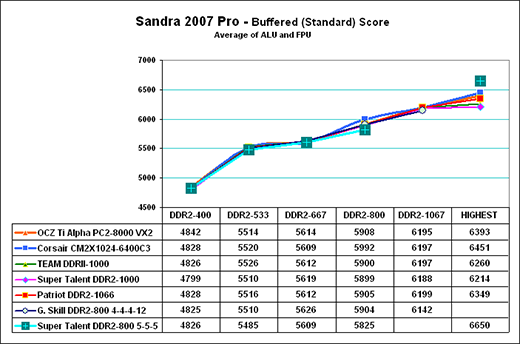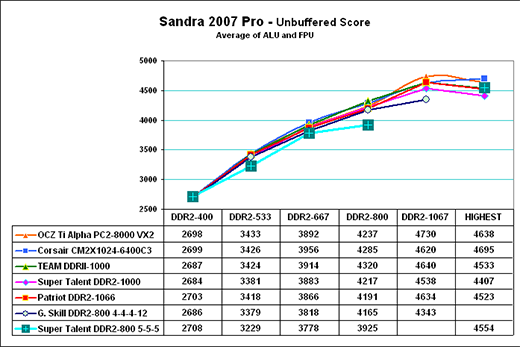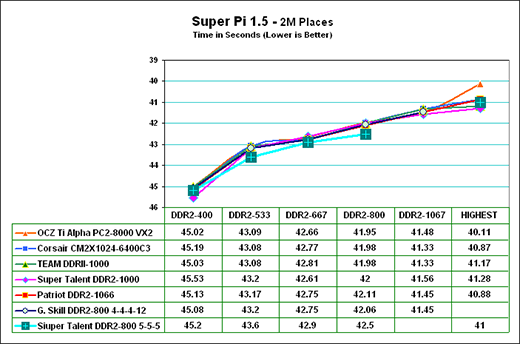Value DDR2-800 from Super Talent: Where Can You Go?
by Wesley Fink on November 29, 2006 12:05 AM EST- Posted in
- Memory
Memory Bandwidth Scaling
Memory bandwidth normally improves with increases in memory speed and reductions in memory timings. This is best illustrated using Performance Scaling charts instead of the bar charts for individual speeds that were used in past memory reviews.
Since the results for high-end memory were so close at all tested speeds, the scale range was reduced to better show the small differences in these memory benchmark results. Please keep this in mind when viewing the charts, since a normal zero scale would make performance differences appear much smaller than these expanded scale charts. Values for the tested memories are included below each chart for reference.
To evaluate memory bandwidth SiSoft Sandra 2007 Professional is used to provide a closer look at scaling for fast DDR2 memory.

The most widely reported Sandra score is the Standard or Buffered memory score. This benchmark takes into account the buffering schemes like MMX, SSE, SSE2, SSE3, and other buffering tools that are used to improve memory performance. Buffered bandwidth performance of the Super Talent memory was virtually the same as the previously tested high-end DDR2 memory at DDR2-800. The Super Talent could not reach DDR2-1067 with stability and topped out at DDR2-1000. Performance at DDR2-1000 cannot be directly compared to other top-end results since the system is modestly overclocked using a DDR2-889 ratio at a FSB setting of 300 where the other memories used a DDR2-1067 ratio.
The Buffered benchmark does not correlate well with real performance differences in games, so our memory bandwidth tests have always included an Unbuffered Sandra memory score. The Unbuffered result turns off the buffering schemes, and we have found the difference in Unbuffered results correlate well with real-world performance differences.

In Unbuffered tests the Super Talent mirrors the best memory tested to DDR2-800, but at a slightly lower performance due to the slower timings. There is no DDR2-1067 performance with the Super Talent and the highest stable speed, DDR2-1000, required a DDR2-889 memory ratio at a bus overclock to 300. It is worth pointing out, however, that memory bandwidth, both buffered and Unbuffered, continue to increase with memory speed.
We also compared results with Version 1.5 of Super Pi - comparing the time to calculate 2 million places of Pi at the different memory speeds. This benchmark measures pure number crunching.

Super Pi results continue to improve all the way to the highest speed that could be reached with stability with each memory. The second result that stands out is how very close the results with all the memories really are.. All four top-end memories perform very similarly. . The Super Talent drops off a bit at the top and bottom due to slightly slower timings in those ranges. The mid-range G. Skill performs similarly until DDR2-1067 where slower timings finally provide a penalty. The Super Talent DDR2-800 value memory drops off a bit at DDR2-800 due to slightly slower timings, but the performance is still remarkably close to the best we have tested. While performance is very close, Super Pi scaling charts continue to show the useful sensitivity of Super Pi as a measurement of memory performance
Memory bandwidth normally improves with increases in memory speed and reductions in memory timings. This is best illustrated using Performance Scaling charts instead of the bar charts for individual speeds that were used in past memory reviews.
Since the results for high-end memory were so close at all tested speeds, the scale range was reduced to better show the small differences in these memory benchmark results. Please keep this in mind when viewing the charts, since a normal zero scale would make performance differences appear much smaller than these expanded scale charts. Values for the tested memories are included below each chart for reference.
To evaluate memory bandwidth SiSoft Sandra 2007 Professional is used to provide a closer look at scaling for fast DDR2 memory.

The most widely reported Sandra score is the Standard or Buffered memory score. This benchmark takes into account the buffering schemes like MMX, SSE, SSE2, SSE3, and other buffering tools that are used to improve memory performance. Buffered bandwidth performance of the Super Talent memory was virtually the same as the previously tested high-end DDR2 memory at DDR2-800. The Super Talent could not reach DDR2-1067 with stability and topped out at DDR2-1000. Performance at DDR2-1000 cannot be directly compared to other top-end results since the system is modestly overclocked using a DDR2-889 ratio at a FSB setting of 300 where the other memories used a DDR2-1067 ratio.
The Buffered benchmark does not correlate well with real performance differences in games, so our memory bandwidth tests have always included an Unbuffered Sandra memory score. The Unbuffered result turns off the buffering schemes, and we have found the difference in Unbuffered results correlate well with real-world performance differences.

In Unbuffered tests the Super Talent mirrors the best memory tested to DDR2-800, but at a slightly lower performance due to the slower timings. There is no DDR2-1067 performance with the Super Talent and the highest stable speed, DDR2-1000, required a DDR2-889 memory ratio at a bus overclock to 300. It is worth pointing out, however, that memory bandwidth, both buffered and Unbuffered, continue to increase with memory speed.
We also compared results with Version 1.5 of Super Pi - comparing the time to calculate 2 million places of Pi at the different memory speeds. This benchmark measures pure number crunching.

Super Pi results continue to improve all the way to the highest speed that could be reached with stability with each memory. The second result that stands out is how very close the results with all the memories really are.. All four top-end memories perform very similarly. . The Super Talent drops off a bit at the top and bottom due to slightly slower timings in those ranges. The mid-range G. Skill performs similarly until DDR2-1067 where slower timings finally provide a penalty. The Super Talent DDR2-800 value memory drops off a bit at DDR2-800 due to slightly slower timings, but the performance is still remarkably close to the best we have tested. While performance is very close, Super Pi scaling charts continue to show the useful sensitivity of Super Pi as a measurement of memory performance










28 Comments
View All Comments
Wesley Fink - Wednesday, November 29, 2006 - link
Super Talent has advised:"This kit is on sale at ewiz for $241.02. You could point readers to
http://www.ewiz.com/detail.php?name=T800UX2GC5">http://www.ewiz.com/detail.php?name=T800UX2GC5&quo...
The kits will also appear at other resellers in the near future.
Frumious1 - Wednesday, November 29, 2006 - link
Try searching for "T800UX2GC5" and you should find it.http://www.ewiz.com/detail.php?name=T800UX2GC5">eWiz
Not in stock anywhere else that I see right now, but Newegg has the T800UX2GC4 at $280 with a $20 mailin rebate, so I bet they'll get the C5 as well, and hopefully closer to $200. In the mean time, try http://froogle.google.com/froogle?hl=en&q=T800...">using a search engine like Froogle/
Postoasted - Wednesday, November 29, 2006 - link
Shouldn't we be suspicious of reviews where the test sample is provided by the product maker?Frumious1 - Wednesday, November 29, 2006 - link
Yes, and we should stop reading hardware websites because that's where all their hardware comes from. We should only pay attention to Newegg.com reviews, because all of those people really purchased the products they're reviewing! (/sarcasm)I've rarely (if ever) been able to match AnandTech performance results with the same RAM chips they use, but then I rarely have the same CPU and motherboard that they've got either. If they push everything to the same limit, you can at least figure the relative differences are there. Truthfully, I don't think more than a small fraction of people that worry about having the biggest epenis need more than DDR2-800 memory. That will get you just about everywhere you need to go with overclocking (except perhaps with the E6300/E6400 on extreme overclocks), so unless you care about the extra 3% potential performance there's not much reason to buy $500 RAM kits.
Wesley Fink - Wednesday, November 29, 2006 - link
Product on AnandTech is not a one-shot deal. If memory or motherboard manufacturers supply hand-picked hardware and users can't duplicate what we find the RMAs go through the roof. This is very expensive for the manufacturer. They quickly learn it is in their best interest to supply a sample with typical performance. The supply issue becomes self-policing.As Editors and enthusiasts we are also not idiots. We do buy samples on a regular basis and compare them to what we find with manufacturer samples. If results are out of line we scream loudly - to the manufacturer and in these pages. Accepting samples from manufacturers for review gets you information MUCH faster, but a review at AT is a privilege - not an obligation. Manufacturers who abuse the "typical sample" rule get moved down in queues or out of our review cycle.
The performance of the Super Talent is nothing spectacular; it is good performance from a fairly rated DDR2-800 memory. There is nothing in our results to raise any concerns. The point of the review was that value DDR2 is almost as good in performance as the best DDR2, and if you are on a tight budget you can save money with value DDR2, within reason, and get more performance by putting the difference in a video card upgrade or a CPU upgrade.
We have asked Super Talent to provide info on where this memory can be purchased. We will pass that along as soon as we receive an answer.
lopri - Wednesday, November 29, 2006 - link
What if the manufacturers are big, I mean HUGE, or if they command a monopoly/duo-poly status in the market? Namely, Intel, AMD, NV, ASUS, et al. Do they consider it an honor to be reviewed @AT? I remember Anand's E6600/E6700/X6800 all hitting ~4.0GHz when they debuted. Retail samples still can't achieve such clocks even months after the initial review, let alone at that time they were merely achieving 3.30~3.60GHz. But it'd be hard to ignore Intel's new products, I'd assume?Wesley Fink - Wednesday, November 29, 2006 - link
There is variation in overclocking among Core 2 Duo samples, but almost all of our retail chips - those we bought - will do in the 3.6GHz to 4.0GHz range. My last retail E6800 does 3.6+ at stock voltage and right at 4GHz on good air cooling. The retail runs 2100 FSB while the Intle sample will not do 1MHz over 1800 FSB.Intel supplied the pre-launch chips, but we have bought everything since. There is definitely variation, but our retail purchases do not vary significantly from the Intel supplied chips, except in maximum FSB which we commented on in the nVidia 680i launch review.
Hippiekiller - Wednesday, November 29, 2006 - link
Poop comes from butts teehee